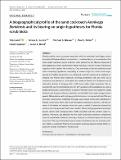A biogeographical profile of the sand cockroach Arenivaga floridensis and its bearing on origin hypotheses for Florida scrub biota
Author
Lamb, Trip; Justice, Teresa C.; Brewer, Michael S.; Moler, Paul E.; Hopkins, Heidi; Bond, Jason E.
Abstract
Florida scrub is a xeric ecosystem associated with the peninsula’s sand ridges, whose
intermittent Pliocene–Pleistocene isolation is considered key to scrub endemism. One
scrub origin hypothesis posits endemics were sourced by the Pliocene dispersal of
arid-adapted taxa from southwestern North America; a second invokes Pleistocene
migration within eastern North America. Only one study to date has explicitly tested
these competing hypotheses, supporting an eastern origin for certain scrub angiosperms. For further perspective, we conducted a genetic analysis of an endemic arthropod, the Florida sand cockroach (Arenivaga floridensis), with two aims: (1) to
reconstruct the peninsular colonization and residence history of A. floridensis and (2)
determine whether its biogeographic profile favors either origin hypothesis. We sequenced the cox2 mitochondrial gene for 237 specimens (65 populations) as well as
additional loci (cox1, nuclear H3) for a subset of Florida roaches and congeners. Using
Network and Bayesian inference methods, we identified three major lineages whose
genetic differentiation and phylogeographical structure correspond with late Pliocene
peninsula insularization, indicating Arenivaga was present and broadly distributed in
Florida at that time. Stem and crown divergence estimates (6.36 Ma; 2.78 Ma) between A. floridensis and western sister taxa span a period of extensive dispersal by
western biota along an arid Gulf Coast corridor. These phylogeographical and phylogenetic results yield a biogeographic profile consistent with the western origin hypothesis. Moreover, age estimates for the roach’s peninsular residence complement
those of several other endemics, favoring a Pliocene (or earlier) inception of the scrub
ecosystem. We argue that eastern versus western hypotheses are not mutually exclusive; rather, a composite history of colonization involving disparate biotas better explains the diverse endemism of Florida scrub.
Date
2017-12-11
Citation:
APA:
Lamb, Trip, & Justice, Teresa C., & Brewer, Michael S., & Moler, Paul E., & Hopkins, Heidi, & Bond, Jason E.. (December 2017).
A biogeographical profile of the sand cockroach Arenivaga floridensis and its bearing on origin hypotheses for Florida scrub biota.
,
(),
-
. Retrieved from
http://hdl.handle.net/10342/8374
MLA:
Lamb, Trip, and Justice, Teresa C., and Brewer, Michael S., and Moler, Paul E., and Hopkins, Heidi, and Bond, Jason E..
"A biogeographical profile of the sand cockroach Arenivaga floridensis and its bearing on origin hypotheses for Florida scrub biota". .
. (),
December 2017.
June 29, 2024.
http://hdl.handle.net/10342/8374.
Chicago:
Lamb, Trip and Justice, Teresa C. and Brewer, Michael S. and Moler, Paul E. and Hopkins, Heidi and Bond, Jason E.,
"A biogeographical profile of the sand cockroach Arenivaga floridensis and its bearing on origin hypotheses for Florida scrub biota," , no.
(December 2017),
http://hdl.handle.net/10342/8374 (accessed
June 29, 2024).
AMA:
Lamb, Trip, Justice, Teresa C., Brewer, Michael S., Moler, Paul E., Hopkins, Heidi, Bond, Jason E..
A biogeographical profile of the sand cockroach Arenivaga floridensis and its bearing on origin hypotheses for Florida scrub biota. .
December 2017;
():
.
http://hdl.handle.net/10342/8374. Accessed
June 29, 2024.
Collections

